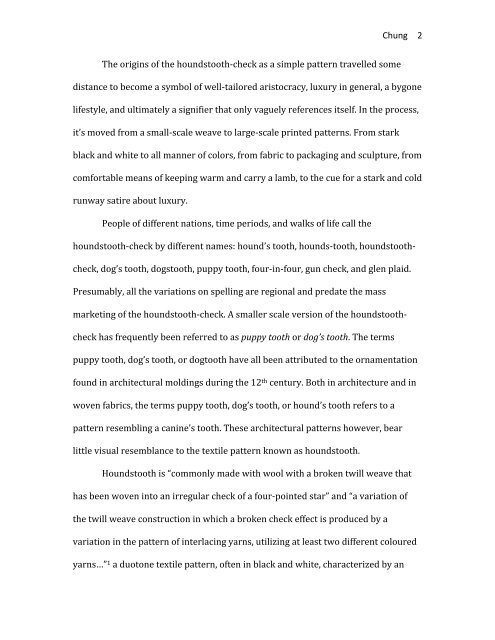Houndstooth - Imprint (NYC)
Houndstooth - Imprint (NYC)
Houndstooth - Imprint (NYC)
You also want an ePaper? Increase the reach of your titles
YUMPU automatically turns print PDFs into web optimized ePapers that Google loves.
Chung<br />
The origins of the houndstooth-‐check as a simple pattern travelled some<br />
distance to become a symbol of well-‐tailored aristocracy, luxury in general, a bygone<br />
lifestyle, and ultimately a signifier that only vaguely references itself. In the process,<br />
it’s moved from a small-‐scale weave to large-‐scale printed patterns. From stark<br />
black and white to all manner of colors, from fabric to packaging and sculpture, from<br />
comfortable means of keeping warm and carry a lamb, to the cue for a stark and cold<br />
runway satire about luxury.<br />
People of different nations, time periods, and walks of life call the<br />
houndstooth-‐check by different names: hound’s tooth, hounds-‐tooth, houndstooth-‐<br />
check, dog’s tooth, dogstooth, puppy tooth, four-‐in-‐four, gun check, and glen plaid.<br />
Presumably, all the variations on spelling are regional and predate the mass<br />
marketing of the houndstooth-‐check. A smaller scale version of the houndstooth-‐<br />
check has frequently been referred to as puppy tooth or dog’s tooth. The terms<br />
puppy tooth, dog’s tooth, or dogtooth have all been attributed to the ornamentation<br />
found in architectural moldings during the 12 th century. Both in architecture and in<br />
woven fabrics, the terms puppy tooth, dog’s tooth, or hound’s tooth refers to a<br />
pattern resembling a canine’s tooth. These architectural patterns however, bear<br />
little visual resemblance to the textile pattern known as houndstooth.<br />
<strong>Houndstooth</strong> is “commonly made with wool with a broken twill weave that<br />
has been woven into an irregular check of a four-‐pointed star” and “a variation of<br />
the twill weave construction in which a broken check effect is produced by a<br />
variation in the pattern of interlacing yarns, utilizing at least two different coloured<br />
yarns…” 1 a duotone textile pattern, often in black and white, characterized by an<br />
2


